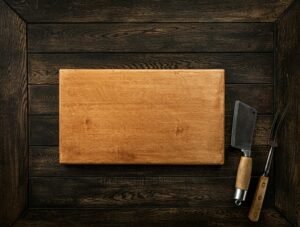The use of wooden cutting boards in the kitchen is a topic of debate. Although many prefer them for their rustic aesthetics and resistance, food safety experts warn about their hygienic risks. Mario Sánchez, nutrition and food safety specialist and creator of the SefiFood podcast, explains why this material is not the best option and what is the safer alternative.
🦠 Why can wooden boards be dangerous?
According to Sanchez, wood is a porous material that retains moisture and dirt, making it an ideal environment for bacterial growth. “On a microbial level, it is among the worst there is,” says the expert, noting that low-quality boards are especially problematic.
One of the biggest risks is cross-contamination. When cutting raw foods such as chicken, meat or fish, bacteria can become trapped in the wood fibers and resist even intense cleaning. This can lead to foodborne infections if the same boards are used to prepare other foods without proper disinfection.
🍽️ Why are wooden boards not used in catering and industry?
Although they are not prohibited, wooden boards are not used in the hospitality and food industry. This is due to the strict hygiene controls that must be complied with in these sectors, where priority is given to materials that facilitate cleaning and reduce the risk of contamination.
Instead, plastic boards of different colors are used, which allow their use to be differentiated according to the type of food (meat, fish, vegetables, etc.), or glass, which is completely impermeable and easy to clean.
✅ The best alternative for home cooking.
For the home environment, Mario Sánchez recommends using quality plastic boards, as they are more hygienic and allow implementing a color separation system to avoid cross-contamination.
Key recommendations for safe use of cutting boards at home include:
🔹 Use different boards depending on the type of food: one for meat, one for vegetables, one for fish, etc.
🔹 Wash boards with hot, soapy water after each use, especially if you have handled raw meat.
🔹 Replace boards when they show cracks or deep marks, as they accumulate bacteria and dirt.
🔹 Avoid mixing raw and cooked foods on the same board without prior cleaning.
🏠What if you already have a wooden board?
If you already use a wooden board at home, there is no need to be alarmed, but it is important to follow strict hygiene guidelines:
Thorough cleaning: Wash it with hot water and soap after each use and dry it thoroughly to avoid moisture build-up.
Regular disinfection: You can rub it with white vinegar or a mixture of water and bleach to reduce the presence of bacteria.
Avoid deep cuts: If the board has many cracks, it’s time to replace it.
📢 Conclusion.
Although wooden boards are traditional and aesthetically pleasing, they are not the best choice from a food safety standpoint. Both nutrition experts and organizations such as the Organization of Consumers and Users (OCU) recommend opting for plastic or glass, ensuring proper cleaning and reducing the risk of food poisoning.
By following these tips, you can enjoy a safer and bacteria-free kitchen. Do you have a wooden board at home? Check its condition and decide if it is time to change it!


